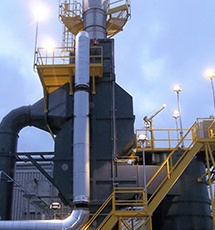
If you haven’t had a Title V permit, but one may be in your future, you may wonder what’s in store. In this post, we’ll take a look at the Title V permit program, which has been a feature of environmental regulation in the United States for over twenty years.
(Permitting and Regulatory Developments)
Title V is a federal operating permit program that is almost always administered by a state or local permitting authority. It is meant to apply to the largest sources of air pollution, known as “major sources” under the program. The threshold to be designated a major source varies, depending on facility location and the type of air pollutant(s) emitted. You should also note that the major source thresholds are different for the federal construction permit program (Prevention of Significant Deterioration, or “PSD” permitting) and the Title V operating permit program.
In some states, facilities that are not major sources under Title V are only required to obtain an initial construction permit and adhere to its terms as long as the process is operated. In others, state-specific operating permit programs, registration programs, permit-by-rule programs, and other alternatives may apply. As in real estate, there are three things that matter when it comes to permit programs: location, location, and location.
The initial intention of establishing the Title V programs was to create a uniform type of permit that would apply across the country and would incorporate all applicable regulations and conditions. It would be a “one stop shop” where a source could go to find all of the air-pollution related rules that it must follow.
(The Oxidizer Permit Protection Myth)
Twenty years later, the industry is in a position to evaluate how well these programs has succeeded, and the reviews are mixed. Title V permit programs were required to contain certain elements and, in that respect, there has been uniformity in the programs among the states. However, the format that the permit application and permit itself follows varies significantly. A Title V permit for a widget factory located in Pennsylvania may contain all of the same information as a permit for an identical widget factory located in South Carolina, but the layout and language used in each case will be totally different.
It’s also a mixed bag when it comes to permit content. Most Title V permits deliver on the promise to include all applicable requirements, but that often results in huge documents – hundreds of pages in many cases – that are virtually unreadable. A source that has every intention of complying with such a document can often inadvertently miss some obscure condition buried in the fine print.
But, for many companies, the biggest reason to avoid a Title V if at all possible hits closer to home. By law, a Responsible Official (“RO”) must certify compliance with permit terms each year. Under certain conditions, making a knowingly false certification can expose the RO to criminal charges. This particular feature of the program led many in the environmental industry recognize the RO can be held personally responsible when Title V was launched in the mid-nineties.
For some sources, like large power plants and oil refineries, there is no choice but to enter the Title V program. The amount of emissions from sources like these are simply too far above major source thresholds to offer any options. Yet there are some sources that can choose, limiting emissions through production limits, add-on controls, or both. And among those that have a choice, most decide to avoid the Title V program, choosing a lesser permit level that usually involves simpler conditions and doesn’t include the legal risks.
We hope this helps you understand Title V, but if you have any questions, please feel free to contact us.








